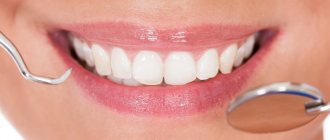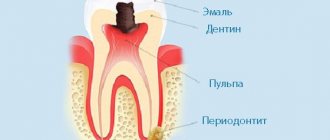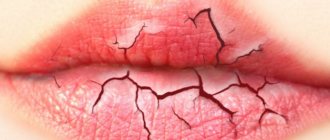Content:
- Possible reasons
- Dental causes of inflammation of the lymph nodes on the chin
- How to understand that the problem is in the lymph nodes
- Diagnostic measures
- How are lymph nodes treated?
- Preventive measures
If the lymph nodes are inflamed, it is important to undergo a comprehensive medical examination.
This condition can be accompanied by many diseases, both related to the field of dentistry and not related to it. Lymph nodes are peripheral organs of the lymphatic system. They perform the functions of a biological filter. Passing through their tissues, lymph enters different parts of the body and internal organs.
If the lymphoid structure has increased, it means there is an inflammatory process. It is necessary to find out as soon as possible what functional disorders it is associated with. This will allow you to create an effective treatment plan and prevent the development of severe complications.
Diagnosis of diseases
Even if the pain is mild at first, over time it can develop into exhaustion. Therefore, do not hesitate to visit a doctor. He will conduct an examination, collect anamnesis, prescribe x-rays and tests. For heart problems, an ECG is additionally performed. If a tumor is suspected, the examination will be more serious, since it is necessary to determine what kind of tumor (benign or malignant), the stage of the lesion, and the presence of metastases.
Taking painkillers can “blur” the clinical picture, so you should not use them without a doctor’s prescription, especially before diagnosis. Only with a correct diagnosis will the doctor be able to determine what to do to eliminate the pathology.
Possible reasons
The lymphatic system is the basis of immunity . It prevents the spread of pathological microorganisms and blocks the occurrence of many disease processes. In various diseases, lymphocytes begin to actively multiply to slow down inflammation. Then the lymph nodes enlarge.
If structures localized under the jaw and in the neck area “grow,” it is most likely an infection, that is, the disorder is caused by bacteria. But sometimes the condition occurs in the absence of infection.
Among the most common infectious causes:
- Colds, viruses. Their pathogens affect the ENT organs, and general intoxication is observed. In this scenario, sore throats, pharyngitis, tonsillitis, acute respiratory viral infections, acute respiratory infections, sinusitis, otitis media, etc. occur.
- Tuberculosis. With lymphadenitis, the entire neck swells. In advanced cases, lymphoid tissues located in the abdominal cavity and chest increase. The pathology is treated conservatively and surgically.
- Dental problems. Pulpitis, caries, periodontitis - all these are provoking diseases.
- Toxoplasmosis. People become infected with it from domestic animals (most often from cats). In addition to the growth of nodes, with this diagnosis the following are observed: high body temperature, headaches, an increase in the size of the spleen and liver. But very often the disease is asymptomatic.
- Venereal pathologies. Transmitted sexually. The body reacts very sharply to most of them, so already in the first days the patient notices that the lymph nodes have become enlarged and began to hurt, and severe weakness has appeared.
- Herpes. It manifests itself as an increase in the volume of lymphoid tissue in the neck, under the jaw and in the groin. Requires competent antiviral therapy.
Among the factors of a non-infectious nature that lead to the appearance of an unfavorable symptom:
- Oncology. It does not matter whether cancer of the lymphatic system or any internal organ is diagnosed. But in the first case, cancer cells quickly spread with the lymph flow, which contributes to the formation of metastases.
- Autoimmune pathologies. These are conditions in which the immune system begins to malfunction, causing serious damage to the body. This group includes systemic lupus, rheumatoid arthritis, type 1 diabetes, etc.
- Allergy. It manifests itself differently in all people. The most common symptoms are skin rashes and itching. But lymph can also be involved in the allergic process.
- Traumatic injuries to the head and face. If a strong pathological process occurs, lymphocytes begin to be actively produced.
Basic methods of treating pathologies
Analgesics will only hide the symptoms for a while, but will not solve the problem. Therefore, it is necessary to treat the disease that causes pain. Let's give some examples.
Jaw injuries
If you are bruised, you should immediately apply a cold compress and bandage to the sore spot. You should definitely see a doctor to rule out other serious pathologies, such as a dislocation or fracture. During treatment, it is important to ensure complete rest for the jaw.
If the cause of pain is a dislocation, the jaw is set into the correct position and fixed with a bandage, which helps ensure its immobility. In case of a fracture, the traumatologist performs splinting or intermaxillary fixation. If it is open, the technique of osteosynthesis with titanium plates is used.
Treatment of osteomyelitis
The tooth involved in the painful process will have to be removed. When performing manipulations, the doctor in most cases opens a purulent focus in the bone and adjacent tissues. Incisions can be made either intraorally or extraorally. All actions are carried out under local anesthesia. After surgery, it is important to carefully clean the wounds. The doctor prescribes antibiotics, vitamins, painkillers and other necessary medications.
With bone necrosis, the doctor determines how to treat osteomyelitis based on the stage of the inflammatory process.
Treatment of TMJ dysfunction
Pathology therapy involves an integrated approach:
- the use of orthodontic techniques that involve correcting the bite;
- operation;
- “remaking” teeth or prosthetics;
- physiotherapy and acupuncture.
Treatment of sore throat
The doctor determines the treatment method depending on the degree of the disease. More often, the patient is treated at home under the supervision of a specialist. The doctor prescribes antipyretic and antiviral drugs, as well as remedies for sore throat.
Using any folk remedies without traditional treatment is a big health risk. They can only be used in some cases as an auxiliary therapy, after consulting with your doctor.
Each case is individual, and the treatment method for one patient may not help another. Therefore, in any case, it is worth contacting a specialist - a dentist or therapist, for example, and if necessary, he will refer you to another doctor.
Dental causes of inflammation of the lymph nodes on the chin
Since very often in their work dentists are faced with huge lymph nodes in patients, let us dwell in more detail on the diseases that cause this symptom:
- Periodontitis. It can occur in acute or chronic form. Leads to tooth loosening and severe pain. If you do not receive qualified dental care in time, there will be a need to remove the affected unit.
- Stomatitis. Causes painful ulcers to appear on the mucous membranes of the mouth. It is the result of injuries, low immunity, vitamin deficiency. In advanced cases, the entire oral cavity becomes covered with wounds. Then active production of lymphocytes is observed.
- Pulpitis. Inflammatory lesion of pulp tissues. A very insidious disease. Through the pulp, pathogenic microorganisms penetrate into the lymph nodes and other tissues. It is important to clean the canals and seal them as soon as possible.
- Advanced caries. Despite the fact that many people do not take caries seriously, it is a rather insidious infectious process. If the deep tissues of the tooth are damaged, the lymph nodes come to the aid of the body - they try to neutralize pathological agents by producing lymphocytes. This can be understood by their increased size.
- Periodontal disease. Causes hypertrophy of periodontal tissues, leading to local hypoxia. Periodontal disease does not cause pain, so most often the patient learns about it by chance during a medical examination for some other condition. With periodontal disease, the gums become lighter, the interdental papillae atrophy, and the dental necks become exposed. If treatment is not started in time, the teeth will begin to loosen and fall out.
- Periodontitis. A disease that develops due to metabolic disorders, neurosomatic abnormalities, poor oral hygiene, and deficiency of vitamins and minerals. It manifests itself as bleeding gums, bad breath, and loose teeth.
- Gingivitis. Inflammatory reaction in the gums. Appears against the background of gastrointestinal pathologies, allergies, infections. The patient experiences bleeding gums even with minor mechanical stress. A burning sensation in the mouth bothers me. Ulcerative-necrotic areas may form.
These are not all dental conditions in which the lymph nodes under the chin become inflamed. In medical practice there are many more such diagnoses. This once again proves that the patient himself will not be able to understand why his submandibular area is swollen.
Periostitis of the jaw
Periostitis, or gumboil, occurs when a person is in no hurry to treat teeth affected by caries, pulpitis or periodontitis. The disease can also appear after tooth extraction if an infection gets inside the wound. Less commonly, pathology occurs as a complication of tonsillitis, influenza or ARVI, due to jaw injuries.
The photo shows periostitis on an x-ray
Periostitis is a purulent-inflammatory disease that affects the periosteum. If left untreated, an abscess forms, inside which pus accumulates. The tumor gradually grows, involving the soft tissues of the oral cavity and face, the parotid zone, as well as the lymph nodes, which may cause the patient to feel as if there is a lump under the jaw.
How to understand that the problem is in the lymph nodes
Among the symptoms indicating damage to the lymph nodes:
- pain in the area where they are located;
- migraine;
- weakness;
- increased body temperature;
- discomfort under the chin;
- unpleasant pulsation in the lower jaw;
- difficulty chewing food;
- swelling noticeable to the naked eye.
If a purulent process develops, the skin in the area of inflammation becomes red and becomes very hot to the touch. Additionally, symptoms characteristic of the disease that provoked the disorder may appear.
Sialadenitis
Salivary stone disease, or sialadenitis, appears due to blockage and inflammation of the salivary glands. The disease most often occurs in the submandibular and parotid areas1. Pathology develops mainly on one side of the jaw. Patients who consult a doctor with this problem complain of swelling under the jaw, chin, or near the ears. In the initial stages, the cheek and neck swell; in later stages, pain occurs when opening the mouth, talking, chewing and swallowing food.
The cause of the lump may be salivary stone disease
Sialadenitis can worsen and recur from 2 to 6 times a year. Dysfunction of the salivary glands and hyposalivation (lack of saliva) contribute to various infectious processes in the oral cavity. The most common is generalized periodontitis, due to which you can lose all your teeth.
“The other day, quite unexpectedly, a lumpy lump appeared under my chin, I went for an ultrasound, and there I was stunned by the news that these were stones in the salivary ducts. There were no other symptoms before. As treatment, they prescribed all sorts of pills and physical procedures, massage, but if it didn’t help, they said that they would put them in surgery and cut them up...”
Flo, review from 32top.ru
Diagnostic measures
Detecting the problem is very simple - the doctor just needs to feel the area under the chin and carefully examine it. To establish the exact cause of the disease, you need:
- Take blood and urine tests. From them you can understand the nature of the “provocateur” (viral or bacterial).
- Donate blood biochemistry.
- Get an ultrasound of the lymph nodes.
If the doctor suspects oncology, the patient is referred for a computed tomography or magnetic resonance imaging scan or a puncture biopsy. These diagnostic measures allow you to make a correct diagnosis and select adequate treatment.
Benign tumor, or lipoma
A lump has appeared under your jaw on the right or maybe on the left, and you are wondering what it is? One of the most common reasons for its appearance is a large wen. To the touch, the formation is soft, motionless and painless. A small lipoma does not pose a serious threat to the body, but if it is not removed, it will continue to grow. The tumor, reaching 5–10 cm in diameter, compresses the nerve endings, disrupts blood circulation and normal cell nutrition. In addition, a large wen is an aesthetic problem, as it spoils the appearance of the face.
A small lipoma does not pose a serious threat
Under unfavorable factors (internal diseases of the body), a lipoma can degenerate into a malignant tumor.
How are lymph nodes treated?
The treatment tactics chosen by the doctor directly depend on the characteristics of the clinical symptoms and the diagnosis. If it's all about a bacterial infection, you can't do without antibiotics. For viruses, antiviral drugs and immunostimulants are indicated. In the case of an autoimmune disorder, the focus is on reducing the activity of specific culprit markers. If cancer is confirmed, chemotherapy, surgery, and immunomodulators are necessary.
If the lymph nodes are enlarged due to a certain dental disease, its step-by-step treatment is carried out. Almost immediately after this, the problem of increased lymphocyte production disappears by itself.
It is extremely important that the patient does not warm the lymph node or apply any compresses unless the doctor has prescribed it. Such actions can aggravate the situation and lead to the development of health-threatening complications.
Cyst of tooth and jaw
Often, patients who go to doctors with complaints of a lump under the jaw on the right or left are diagnosed with a “cyst”. Pathology can develop due to diseased or poorly treated teeth, various jaw injuries, and ENT diseases. A cyst can go unnoticed for a long time, since it is small in size and does not cause any pain. Problems arise as it grows. A formation can be detected in the initial stages only on an x-ray during a routine examination at the dentist.
The cyst may go undetected for a long time
Read about what types of cysts there are and how to treat them in the feature article on the website.
The cyst must be removed surgically. If it is allowed to grow further, it will begin to destroy the bone tissue of the jaw, can lead to facial deformation, and be complicated by such a serious disease as osteomyelitis.
Will it be possible to save the tooth after removing the cyst? This is possible if all procedures are carried out under a microscope. A high-precision optical device will allow the doctor to see the clinical picture in detail, to precisely and precisely influence only the tumor itself, while preserving healthy tissue as much as possible. Removal of a cyst is often performed with resection (cutting off) of the root apex. And the microscope allows you to carry out the operation in the most gentle way and even fill the canals in a retrograde way, that is, through the apex of the root, if, for example, there is a crown on the tooth (without the need to remove it). But, of course, saving is possible if the situation is not too advanced.
Preventive measures
No one is immune from the problem described. But there are ways to minimize the risk of its occurrence. Among them:
- receiving qualified medical care for any ailments;
- annual laboratory tests;
- timely treatment of emerging dental diseases;
- sanitation of the oral cavity every six months;
- following medical prescriptions.
Take care of your health, and the risk of enlarged lymph nodes will be minimized.
Atheroma of the sebaceous gland
A tumor resulting from blockage of the sebaceous glands is called atheroma or sebaceous cyst. Most often it occurs where there are a lot of sebaceous glands - on the head or face (mainly below the level of the mouth, under the jaw). Soft to the touch, mobile, painless. The lump under the jaw on the right or left increases in size very slowly and usually does not exceed 40 mm in diameter.
Atheroma most often occurs where there are many sebaceous glands
The bad thing is that atheromas often fester. They can communicate with the surface of the skin - in this case, a cheesy mass can seep out through the hole, which smells unpleasant. To avoid such unpleasant consequences, atheroma, like all neoplasms, is removed surgically.
Internal subcutaneous pimple or boil
If there is a small lump under the jaw on the left or right, then this may well be an ordinary subcutaneous pimple. Many people do not think that such a tumor poses a serious threat, but if you start squeezing the pimple, the infection can go inside the body, and you will end up on the surgical table. Moreover, if such pimples appear frequently and do not go away for a long time, then this signals problems with the internal organs, excretory, reproductive and endocrine systems.
The photo shows a boil under the jaw
Do not under any circumstances try to crush, puncture or heat the lumps under the jaw. You can bring an infection inside, cause complications and the appearance of rashes in new places.
Osteomyelitis
Pain under the chin causes osteomyelitis, a dangerous disease that affects all elements of the bone. Without timely treatment, this disease can lead to serious complications.
© shutterstock
Osteomyelitis is an infection in the bone. Smokers and people with chronic diseases such as diabetes or kidney failure are more at risk of developing osteomyelitis.
Most cases of osteomyelitis are caused by staphylococcus bacteria. They can enter through injuries with open wounds, through the bloodstream or after surgery.
Signs of illness
Signs of osteomyelitis include:
- High temperature;
- Swelling and redness in the area of infection;
- Pain near the chin (at the site of the lesion), increasing with palpation;
- Swelling of the lymph nodes;
- Bad feeling.
All these signs should prompt an urgent visit to a specialist.
Treatment options
The most common treatments for osteomyelitis are surgery to remove infected or dead bone, followed by intravenous antibiotics in the hospital.
Why does the chin, lower or upper jaw hurt after implantation?
In the first hours and days after implantation, pain almost always occurs. This is due to the fact that a small, but still operation was performed on the jaw, after which the tissue is restored. Typically, after surgery, doctors prescribe strong painkillers to patients to ease their condition.
Normally, pain goes away on the third or fifth day after dental surgery. If the pain does not go away during this time, you need to consult a dentist. Perhaps some mistakes were made during the implantation process that can be quickly corrected.










